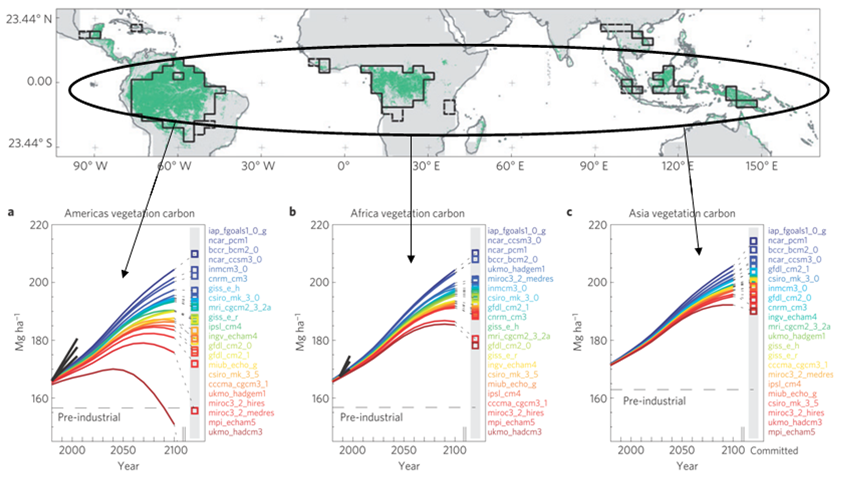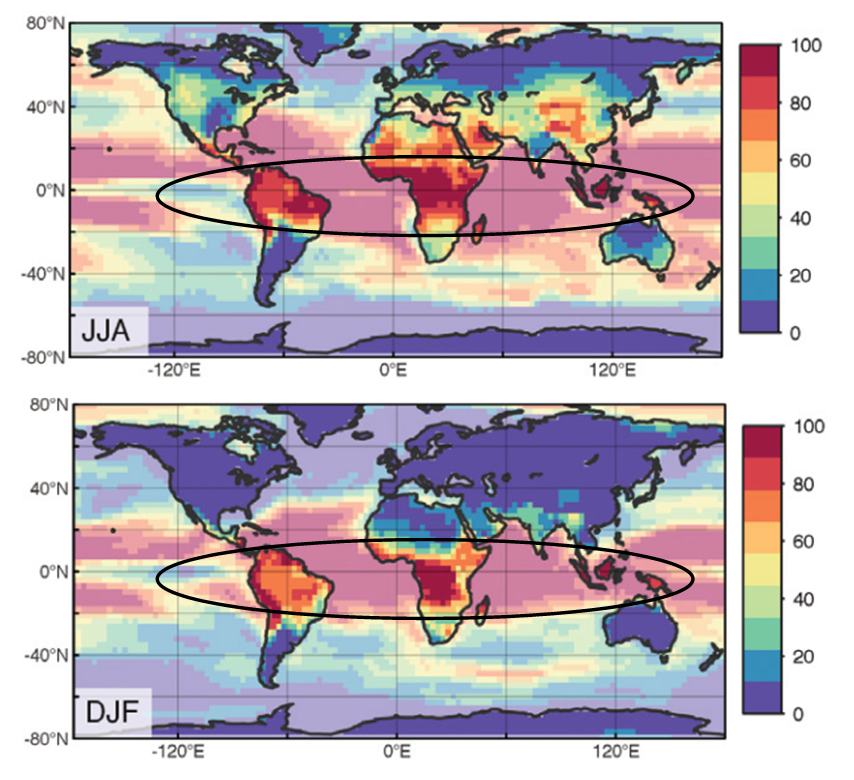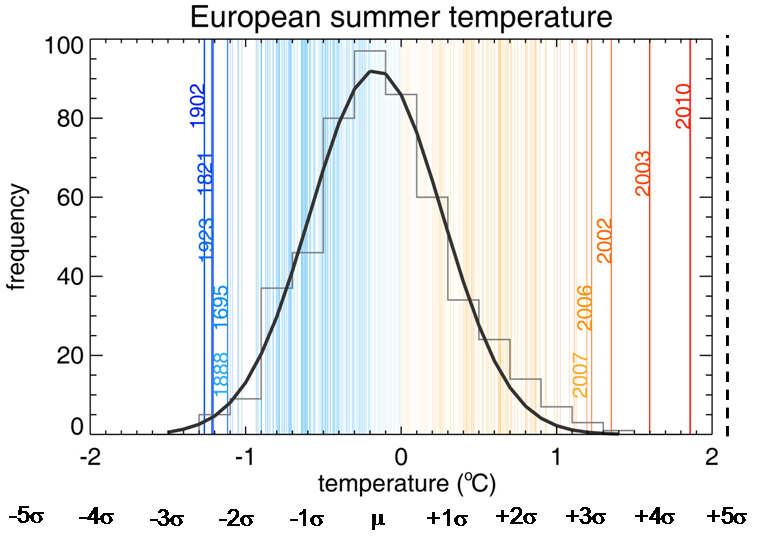Will Tropical Forests Remain Carbon Sinks?
Posted on 31 May 2013 by AlexanderAc
This short post was inspired by the excellent talk of professor Hans Joachim Schellnhuber, director of the Potsdam Institute For Climate Change Research. The aim of his presentation was to give an update for European policymakers on the latest knowledge of the climate science with regard to climate change and its impacts on our societies.
I one of the slides Schellnhuber showed the results of recent study published by Chris Huntingford et al. 2013 (Nature GeoScience, PDF):
Fig. 1: Tropical forest biomass predictions for the Americas (a), Africa (b) and Asia (c) by the MOSES–TRIFFID model forced by 22 climate models. Normalized estimates of Cv (carbon stock) from inventory data (2.5%, mean and 97.5% con?dence levels) are the short black curves forAmericas andAfrica. Horizontal lines (large dashes) are estimated pre-industrial values, year 1860.
According to these results, though with quite large variability, most of the dynamic climate models coupled with vegetation models show that tropical forest will continue to be net carbon sinks by the end of this century, and maybe further on. Authors attribute this behavior mainly to the CO2 fertilization effect, which should counteract other negative effects of climate change, such as increased heat or extreme drought.
As an plant ecophysiologist I have no problem accepting these good results, assuming that effect of increased CO2 on plant physiological processes is properly parameterized/represented in the model. Moreover, observations of carbon stocks of tropical forest show that all models (and again, probably not insignificantly) are underestimating the actual rate of carbon sequestration.
Some problems with acceptance of these results have risen later, when Schellnhuber continued with his presentation, showing the results from the recent climate report for the World Bank, where he was the main author. The results are following (p39):
Fig. 2: Multi-model mean of the percentage of months during 2080-2100 that are warmer than 5-sigma relative to present-day climatology (World Bank report, 2012). Note that absolute changes in temperature are expected to be higher in extra-tropical regions.
Here, tropical regions are the ones which suffer from climate change most, at least in terms of heat. Striking is the extent of the temperature extremes which could occur in the tropics, if the models projections are correct of course. Practically all tropical regions will experience 60-100% occurrence of 5-sigma extreme heat events during both, summer and winter months. Which means that weather conditions that are under today climate occurring once per million year, will occur every year in most of the tropical regions, especially in Africa andAsia.
To put it into another perspective with an analysis of extreme heat events in Northern Hemisphere:
Fig. 3: This diagram shows distribution of summer temperatures in Europe during the last 500 years relative to the 1970-1999 climatology (Barriopedro et al., Science, 2011). Dashed vertical line is depicting hypothetical 5-sigma event, which has a probability of occurring by change less than 1:1000000. Interannual temperature changes in the tropics are smaller in the tropics, thus 5-sigma event requires smaller temperature increase compared to the rest of planet.
The summer heat wave of 2003 caused that European forest became net source of carbon and released equivalent of 4 years carbon absorption during normal years (Ciais et al., Nature, 2005). Droughts of 2005 and 2010 in Brazil turned tropical forest during these years into net carbon source (Lewis et al., Science, 2011), although the longer-term effects of these droughts, as well as resilience of tropical forest to drought, are still under the debate. There is also some indication, that tropical species are more susceptible to changing climate, since they usually do not experience temperature and weather extremes to the extent that species outside the tropics do.
Summary
It remains questionable, how tropical forests will maintain their carbon absorbing ability, if conditions not experienced for thousand of years (if not more) should occur every year by the end of this century, and not only during the summer, but also during the winter. Hopefully, future research brings us more relevant information.































 Arguments
Arguments

































I am assuming that the amount of rainforest in these models are kept constant and the quality of rainforest remains at today's level.
Tuening rainforest to pasture (or non proud soils due to nutrient depletion or production of laterite soils) will reduce the abilitottoman continue as a carbon sink.
Interesting paper. It is sort of intuitive that an ecological system as intense as rainforest would already be close to saturation as a carbon sink. What is interesting though is that recent research has shown that the CO2 fertilisation affect, and hence (presumably) the carbon sink potential of plant biomass, is most apparent in arid and semi-arid regions which are already showing rapid greening in response to elevated CO2.
The major benefit in a dry climate of higher CO2 levels is that a plant can get the CO2 it needs from the air with fewer stomata in its leaves. Fewer stomata means less water loss from the leaf and hence the plant can produce the same carbohydrates through photosynthesis with less water (or more carbohydrates with the same amount of water).
Research has been published in Geophysical Research Letters that shows an increase of 11% in green foliage cover between 1980 and 2011, mainly in arid and semi-arid areas. This means that as the rain forests decline as a carbon sink that the slack may be taken up as arid areas green and increase their role as a carbon sink. Isn't nature wonderful!
http://onlinelibrary.wiley.com/doi/10.1002/grl.50563/abstract
"According to these results, though with quite large variability, most of the dynamic climate models coupled with vegetation models show that tropical forest will continue to be net carbon sinks by the end of this century, and maybe further on."
This statement confuses stock and flow variables. Sinks are stock variables. As long as the tropical rainforests contain a stock of carbon (i.e., as long as they continue to exist), they're carbon sinks. That's true regardless of the magnitude and direction of the flow variable (net inflow or outflow). What the models show is that there will be a net inflow of carbon into the tropical rainforests by the end of the century, meaning that carbon stock (the size of the carbon sink) will continue to increase over that period.
Matthew L, I agree entirely that nature is wonderful. Unfortunately I'm not optimistic that nature will prevent us causing a mass-extinction if our civilisation continues along the path of increasing fossil fuel burning. There have been mass-extinctions in the past when large changes in temperature have happened in a short time (on a geological time-scale), and we seem to be on track to cause similar abrupt changes in temperature (unless we change course radically). Even if there isn't a mass extinction, I think that global warming is likely to cause food security problems for a sizeable proportion of humanity. I'm not sure how well the world's agricultural systems will cope with the high temperature extremes and changes in rainfall in the coming decades. CO2 fertilisation won't necessarily help in the future in areas where plants are unable to grow due to extreme heat or drought.